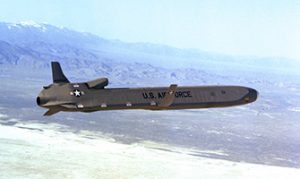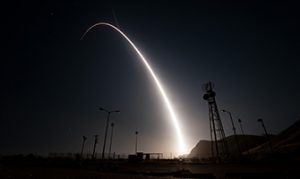Ballistic missiles are powered initially by a rocket or series of rockets in stages, but then follow an unpowered trajectory that arches upwards before descending to reach its intended target. Ballistic missiles can carry either nuclear or conventional warheads.
There are four general classifications of ballistic missiles based on their range, or the maximum distance the missile can travel:
- Short-range: less than 1,000 kilometers (approximately 620 miles), also known as “tactical” ballistic missiles.
- Medium-range: between 1,000 and 3,000 kilometers (approximately 620-1,860 miles), also known as “theater” ballistic missiles.
- Intermediate-range: between 3,000 and 5,500 kilometers (approximately 1,860-3,410 miles)
- Long-range: more than 5,500 kilometers (approximately 3,410 miles), also known as intercontinental or strategic ballistic missiles. Intercontinental ballistic missiles (ICBMs) can fly much further than the minimum range; for example, Russia could hit Chicago with an ICBM launched from the Krasnoyarsk ICBM base, which is located 9,156 kilometers (5,689 miles) away.
Ballistic missiles have three stages of flight:
Boost Phase begins at launch and lasts until the rocket engine(s) stops firing and the missile begins unpowered flight. Depending on the missile, boost phase can last three to five minutes. Most of this phase takes place in the atmosphere.
Midcourse Phase begins after the rocket(s) stops firing. The missile continues to ascend toward the highest point in its trajectory, and then begins to descend toward Earth. This is the longest phase of a missile’s flight; for ICBMs, it can last around 20 minutes. During midcourse phase, ICBMs can travel around 24,000 kilometers per hour (15,000 miles per hour).
Terminal Phase begins when the detached warhead(s) reenter the Earth’s atmosphere and ends upon impact or detonation. During this phase, which can last for less than a minute, strategic warheads can be traveling at speeds greater than 3,200 kilometers per hour (1,988 miles per hour).
 Cruise missiles are unmanned vehicles that are propelled by jet engines, much like an airplane. They can be launched from ground, air or sea platforms.
Cruise missiles are unmanned vehicles that are propelled by jet engines, much like an airplane. They can be launched from ground, air or sea platforms.
Cruise missiles remain within the atmosphere for the duration of their flight and can fly as low as a few meters off the ground. Flying low to the surface of the earth expends more fuel but makes a cruise missile very difficult to detect.
Cruise missiles are self-guided and use multiple methods to accurately deliver their payload, including terrain mapping, global positioning systems (GPS) and inertial guidance, which uses motion sensors and gyroscopes to keep the missile on a pre-programmed flight path. As advanced cruise missiles approach their target, remote operators can use a camera in the nose of the missile to see what the missile sees. This gives them the option to manually guide the missile to its target or to abort the strike.
To learn about missile defense, check out our fact sheet.
Sources: Department of Defense, Missile Defense Agency, Federation of American Scientists.


